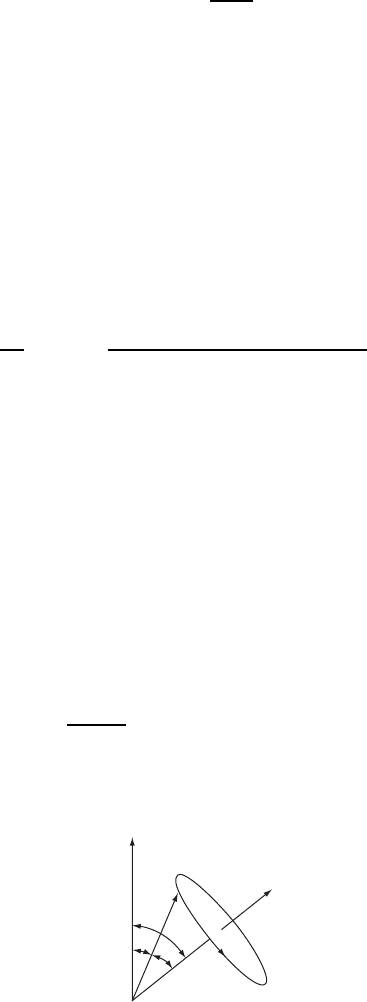Gersten J.I., Smith F.W. The Physics and Chemistry of Materials
Подождите немного. Документ загружается.


484 CHARACTERIZATION OF MATERIALS
L
'
II'
R
'
L
R
C
V
C
AB
Figure W22.50. Ac bridge.
sample in the shape of a ring and winds N uniform turns of wire around it to fashion
an inductor. The inductance is given by
Lω D
0
r
ωhN
2
2
ln
b
a
,W22.169
where it is assumed that the ring is in the form of an annulus of inner radius a, outer
radius b, and thickness h. The inductance is seen to be a complex quantity and may
be regarded as a pure inductor in series with a pure resistor. The reactance of the pair
is X DiωLω D R iω Re Lω R iωL,where
R D
ω
0
2
hN
2
2
ln
b
a
.W22.170
The inductor is inserted into one leg of a bridge, as shown in Fig. W22.50. The other
legs of the bridge consist of a variable inductor L
0
in series with a variable resistor R
0
,
and two capacitors, each with capacitance C. An ac voltage of frequency ω is imposed
across the bridge. The value of R
0
and L
0
are adjusted until a null reading for the
voltage occurs across the terminals A and B. The bridge is then balanced with L
0
D L
and R
0
D R. The values of
1
ω and
2
ω are then determined from Eqs. (W22.169)
and (W22.170).
RESONANCE TECHNIQUES
The ability of scientists to determine resonance frequencies accurately has played a
central role in the development of atomic and nuclear physics and gas-phase chemistry.
The techniques were later applied to liquid-phase chemistry and ultimately to solid-
state measurements. In the following sections several of these resonance techniques are
described. The discussion begins with nuclear magnetic resonance spectroscopy. This
is followed by a consideration of nuclear quadrupole resonance spectroscopy. Then
electron spin resonance is studied. Finally, the M
¨
ossbauer effect is described.
W22.30 Nuclear Magnetic Resonance
It is possible to obtain useful information concerning the composition of a material
and the local environment of its individual nuclei by performing nuclear magnetic

CHARACTERIZATION OF MATERIALS 485
resonance (NMR) measurements. The procedure involves placing a sample of the
material in a constant uniform magnetic field. A weak perturbing radio-frequency
magnetic field is simultaneously applied to the sample while its frequency is varied
until maximum power is delivered by the RF field to the sample. This frequency is
called the resonance frequency. For a given magnetic field it is found that each nucleus
has its own particular resonance frequency. The strength of the resonance is directly
proportional to the amount of that particular nucleus present in the sample. This is
the basis of the use of NMR as a tool for determining the chemical composition. In
addition, there are slight shifts of the resonance frequency caused by variations of the
local chemical environment of the nucleus. This is due to the nuclei coupling to the
surrounding electrons by magnetic interactions and the electrons also coupling to the
applied magnetic field. Since the electron distribution reflects the chemical environment
(e.g., which chemical bonds are present and what the NNs and next-NNs are), one may
also use NMR to obtain this kind of information as well. From a knowledge of the
NNs and next-NNs one is often able to piece together the structure of complicated
chemical compounds or solids. The utility of NMR hinges on the ability to generate
uniform magnetic fields and to perform resonance measurements with extremely high
precision. The utility is also based on having a database of NMR signals from known
sequences of atoms with which a comparison may be made in determining the structure
of a complex molecule or solid.
Some of the main features of NMR follow directly from a classical-mechanical
theory, although the correct description must be formulated within the framework of
quantum mechanics. The need for a quantum theory stems from the fact that angular
momentum is quantized. A nucleus has an angular momentum operator given by
J D I¯h, W22.171
where I is a vector of spin matrices (i.e., I
x
, I
y
,andI
z
are square matrices). The
magnitude of the angular momentum, according to quantum mechanics, is given by
¯h[II C 1]
1/2
,whereI is either a nonnegative integer or a half integer. The number
of rows in the matrices I
x
, I
y
,orI
z
is 2I C1. For nuclei, I is small and quantum
effects are important. For pedagogic reasons, however, the discussion begins with the
classical theory. The quantum-mechanical treatment is covered in Appendix W22A.
A nucleus has a magnetic moment directed along the spin angular momentum vector
m D g
I
N
¯hI D ¯h8I,W22.172
where
N
D e¯h/2M
p
D 5.050824 ð10
27
J/T is the nuclear magneton, g
I
is the
nuclear g factor, and 8 D g
I
N
. Each nucleus has its unique value of 8, and this
is what gives NMR its chemical (and isotopic) specificity. Impose a uniform magnetic
induction B D B
0
O
k on the nucleus. The nucleus will experience a magnetic torque and
this will cause the spin angular momentum to change its direction in time according to
dI
dt
D
m
× B
¯h
D 8B
0
I ×
O
k D I
× Z.W22.173
This is in the form of a precession equation for I. The precession frequency is the
magnitude of the vector
Z D
8B
¯h
.W22.174

486 CHARACTERIZATION OF MATERIALS
TABLE W22.3 Spin I =
1
2
Nuclei Commonly
Used in NMR Spectroscopy
Isotopic
Abundance f (B D 1T)
Nucleus (%) (MHz)
1
H 99.985 42.5764
13
C 1.10 10.7081
15
N 0.366 4.3172
19
F 100 40.0765
29
Si 4.67 8.4653
31
P 100 17.2510
89
Y 100 2.0949
109
Ag 48.161 1.9924
119
Sn 8.59 15.9656
183
W 14.3 1.7956
199
Hg 16.87 7.7121
205
Tl 70.476 24.9742
207
Pb 22.1 9.0338
Source: D. R. Lide, ed., CRC Handbook of Chemistry
and Physics, 75th ed., CRC Press, Boca Raton, Fla.,
1997.
A list of some nuclei commonly used in NMR, along with their precession frequen-
cies, f D /2 is given in Table W22.3. Many nuclei have I D 0 and so are not
NMR-active (e.g.,
12
C,
16
O,
28
Si,
56
Fe).
The effect of the electrons, which are sensitive to the chemical environment, is to
partially shield the nucleus from the magnetic field. The magnetic induction may be
written as
B D
$
I
$
· B
0
,W22.175
where
$
is called the shielding tensor. It may be written as the sum of an isotropic
part,
$
I, and an anisotropic part,
$
(i.e.,
$
D
$
I C
$
). The effect of the shielding
is usually described in terms of a chemical-shift parameter, υ. The value is usually
reported relative to a standard value
υ D
st
st
ð 10
6
,W22.176
where
st
is the frequency of the standard. The frequency shifts for protons typically
range from 0 to 10 ppm. For
13
C they range up to ³ 200 ppm. The standard used is
often the tetramethylsilane (TMS) molecule, (CH
3
)
4
Si.
If the precession equation is separated into components, three equations are obtained:
dI
x
dt
D I
y
,
dI
y
dt
DI
x
,
dI
z
dt
D 0.W22.177
It follows that I
z
and I remain constant in time. The x and y components undergo a
precessional motion
I
x
D I
0
cos t, I
y
DI
0
sin t, W22.178

CHARACTERIZATION OF MATERIALS 487
where I
0
is a constant in the classical theory. The value of I
z
is that appropriate to
thermal equilibrium, and is given in terms of the Brillouin function:
hI
z
iDIB
I
8IB
k
B
T
,W22.179
which is analogous to Eqs. (9.23) and (9.24).
In a solid, the nuclei interact with the other atoms of the material through a variety
of interactions, including spin–orbit and spin–spin interactions. These interactions
have two effects. First, they cause the z component of the nuclear spin to relax to its
equilibrium value, with a characteristic relaxation time T
1
,thatis,
dI
z
dt
D
I
z
hI
z
i
T
1
.W22.180
The parameter T
1
is called the longitudinal or spin-lattice relaxation time. Second, they
cause the precessional motion to become phase interrupted. Introduce a phenomeno-
logical damping term to account for this spin–lattice interaction:
dI
x
dt
C
I
x
T
2
D I ×
x
,W22.181
dI
y
dt
C
I
y
T
2
D I ×
y
,W22.182
The parameter T
2
is called the transverse relaxation time.Itisassumedthatthereis
no difference in the phase-interruption time constant for x-ory-spin components.
It is convenient to form the combination I
C
D I
x
C iI
y
and combine the two preces-
sion equations into one:
d
dt
C i C
1
T
2
I
C
D 0.W22.183
This is an equation for damped oscillation of the spin.
Next, introduce the perturbing magnetic field, H
0
t, at right angles to B. It is taken
to be circularly polarized, since this leads to a simpler formula. Thus
H
0
x
D H
0
cos ωt, H
0
y
DH
0
sin ωt. W22.184
The dynamical equation becomes
d
dt
C i C
1
T
2
I
C
D i
0
I
z
expiωt, W22.185
where
0
D
0
8H
0
/¯h. In the limit of weak RF fields, I
x
and I
y
will be small, so I
z
will differ from hI
z
i only by terms of order H
0
2
.HenceI
z
will be approximated by
hI
z
i. A steady-state solution for I
C
is found by writing I
C
D I
0
expiωt,so
I
0
D
0
hI
z
i
ω i/T
2
.W22.186

488 CHARACTERIZATION OF MATERIALS
B
W
w
H'
I
Figure W22.51. Precession of a nuclear spin around the magnetic-induction vector.
This equation demonstrates that as the frequency ω approaches the resonance frequency
, the amplitude of I
C
can grow to be large, limited only by the shortness of T
2
.The
resonance is detected by monitoring the power transfer from the RF circuit to the spin
system. It shows up by adding extra inductance and resistance to the RF circuit. This
power, of course, is ultimately transferred to the translational motion of the other atoms
and so heats the material. A sketch of the precessing magnetic dipole is presented in
Fig. W22.51.
The resonance frequency of a nucleus depends on the local magnetic field. In addi-
tion, for spin I ½ 1, nuclei also possess electric-quadrupole moments. These interact
with electric fields and affect the NMR spectrum in important ways. The local magnetic
field is given by the sum of the applied field and the fields due to all the other elec-
tronic and nuclear magnetic moments of the material. Since these moments are likely
to be oriented in an almost random manner, each nucleus will experience a different
magnetic field and hence have a different resonance frequency. Instead of the sample
exhibiting a sharp NMR resonance line, the line will be inhomogeneously broadened.
It is important to make a distinction between the magnetic moments participating
in the resonance (such as protons interacting with other protons in an proton NMR
signal) and other moments (such as protons interacting with Fe atomic spins in iron).
In this example, the spin–spin interaction of the protons is approximately included
in the parameter T
2
. The other interactions contribute to the inhomogeneous broad-
ening of the NMR line. This limits the ability to resolve closely spaced resonance
lines.
There are at least two methods to overcome this limitation. One may do NMR on
a liquid instead of a solid. There is a phenomenon called motional line narrowing
which can occur in liquids and will now be explained. As the nuclei move about due
to their thermal motion, the contribution to the local magnetic field from other nuclei
is as likely to be in one direction as in the opposite direction. Its average value is
zero, although the mean-square fluctuation remains nonzero. Let the contribution to
the precession frequency of a given nucleus from the other magnetic dipoles of the
material be denoted by
00
t. As a simple model, suppose that it may assume only
two values, C
00
and
00
, and that there is a 50% probability of switching from one
value to the other every : seconds. The mean value of the square of the accumulated
phase after a time t is then
t
0
00
t
0
dt
0
2
D
t
:
002
:
2
,W22.187

CHARACTERIZATION OF MATERIALS 489
where t/: is the number of opportunities for switching that occur. If the effective
dephasing time is determined by when this is ³ 1 radian, an estimate for T
2
is obtained:
T
2
D
1
002
:
.W22.188
As the thermal motion increases, : becomes smaller and the dephasing time becomes
longer.
A second technique for reducing the inhomogeneous width is called magic-angle
spinning. It permits high-resolution NMR to be applied to solid-state samples. It may
be accomplished by either actually physically spinning the solid about an axis making
an angle D 54.7
°
with the dc magnetic field and using a very weak RF field, or
holding the sample stationary but arranging that the ratio of the RF magnetic field to
the dc magnetic field be equal to H
0
/H
0
D tan54.7
°
D 2
1/2
. To understand how this
comes about, consider the magnetic dipole–dipole interaction between the magnetic
dipoles located at the various sites r
i
in the solid:
U D
0
4
N
iD1
N
jDiC1
3m
i
· Or
ij
m
j
· Or
ij
m
i
· m
j
r
3
ij
,W22.189
where r
ij
Djr
i
r
j
j. It will be assumed that the magnetic field is strong enough so
that m
i
precesses rapidly around the applied magnetic induction B
0
. On the average,
the magnetic moment therefore points along the direction of the magnetic field. The
angular factor in the numerator may then be written as
2P
2
cos
ij
D 3cos
2
ij
1 D 3
O
B
0
ÐOr
ij
2
1,W22.190
where P
2
cos is the second-order Legendre polynomial. Now suppose that the solid
is spun around some axis with an angular velocity
s
(Fig. W22.52). There is an
identity, called the addition theorem for spherical harmonics,
P
L
cos
ij
D
4
2L C1
L
MDL
Y
Ł
LM
, Y
LM
ij
,
ij
, W22.191
B
0
q
q
ij
y
ij
r
ij
^
W
s
Figure W22.52. Orientation of the external magnetic field, B
0
, the displacement unit vector,
Or
ij
, and the rotation velocity,
s
.

490 CHARACTERIZATION OF MATERIALS
where the Y
LM
are spherical harmonics and denotes an azimuthal angle (not shown in
the figure) around vector
Z
s
. In the course of the angular motion, the terms involving
M 6D 0 average out, so
P
2
cos
ij
! P
2
cos
ij
P
2
cos . W22.192
If cos
2
D
1
3
(i.e., D 54.7
°
), then P
2
cos D 0 and the spin–spin interaction is
effectively removed as a first-order perturbation in the problem. This allows the lines to
become very narrow when the solid is spun at the magic angle. It must be emphasized,
however, that magic-angle spinning is only effective in eliminating the broadening due
to “like” spins. It does not eliminate inhomogeneous broadening due to other sources.
It is possible to remove some dipole–dipole broadening effects due to the interac-
tions between unlike spins by employing a technique called dipolar decoupling.For
example, suppose that
1
H is present and one is interested in studying the
13
Cspectrum.
Normally, the two spins would interact in such a way as to broaden the spectra. A
strong RF field is applied whose frequency resonates with the protons. The spins of
the protons are made to flip up and down rapidly and hence their magnetic moments
average to zero. Their interaction with the
13
C nuclei is suppressed.
It is also possible to use a technique called cross-polarization to increase the sensi-
tivity of the NMR resonance of one of the spins of a multispin system. For example,
there may be many more
1
H nuclei present than
13
C nuclei. In this technique one
applies two RF frequencies which effectively lock the nuclear resonances together.
This occurs when the Hahn–Hartmann condition applies (i.e., 8
C
B
C
D 8
H
B
H
). The
Zeeman splittings of the two nuclei are made degenerate with each other, and this
facilitates the resonant exchange of energy via the spin–spin interaction. The net result
is a transfer of magnetization from the majority
1
H nuclei to the minority
13
C nuclei
and a strengthening of the
13
C signal.
It should also be mentioned that in some solids the analysis of the NMR line shape
reveals that the interaction between “like” spins leads to non-Lorentzian resonances.
This reflects a limitation of the Bloch equations in which one attempts to parametrize
all dephasing effects in terms of a single time, T
2
. The measured line shape may contain
important information concerning the interatomic distances and the short-range order,
in general.
The relaxation time T
1
can be very long, in the range of minutes or longer. In some
cases this long relaxation time limits the ability to carry out NMR experiments on
solids. On the other hand, it also implies that quantum coherence is being maintained for
a long period of time. This could potentially be utilized in the construction of quantum
computers, which rely on the quantum-mechanical coherence being maintained during
the course of a calculation.
NMR is a long-established technique and there are a variety of ways of employing
it. There are powerful methods using time-programmed pulses of RF magnetic fields,
but these will not be discussed here.
It is also possible to obtain information concerning the density of conduction
electrons by measuring the Knight shift. At a given frequency the nuclear magnetic
resonance of a nucleus in a metal occurs at a different value of the magnetic field than
it would in an insulator. The Knight shift is defined as B/B. This is due to the fact
that the conduction electrons exhibit magnetism, and this modifies the local magnetic
field experienced by the nucleus. The interaction responsible for this shift (called the

CHARACTERIZATION OF MATERIALS 491
Fermi contact interaction) is a point-magnetic interaction between the electron-spin
magnetic moment and the magnetic moment of the nucleus. An expression for this
interaction may be obtained by regarding the nucleus as a small magnetized sphere of
radius b and allowing the size of the sphere to shrink to zero. The magnetic induction
inside the sphere can be shown, by elementary magnetostatic arguments, to be given
by B
in
D
0
g
I
N
I/2b
3
. The interaction energy is V D g
e
B
s · B
in
,so
V D
2
0
3
g
e
B
g
I
N
s · Iυr, W22.193
g
e
being the electron g factor and
B
the Bohr magneton. The substitution
1/4b
3
/3 ! υr is also made in deriving this formula. Applying first-order
perturbation theory, one finds an expression for the energy of the nuclear magnetic
moment in the magnetic field:
E Dg
I
N
I ·
B
2
0
3
g
e
B
sj 0j
2
,W22.194
where j 0j
2
is the probability density for finding the electron at the nucleus. The
Knight shift, K, is therefore
K
B
B
D
2
0
g
e
B
hs
z
i
3B
j 0j
2
.W22.195
This may be expressed in terms of the magnetic susceptibility E and the magnetic
permeability using the relation hs
z
i/B D E/n
0
g
e
B
,wheren is the electron density.
Typical experimental values for the Knight shift for the alkali metals
7
Li,
23
Na,
39
K,
and
87
Rb are 0.026%, 0.112%, 0.265%, and 0.653%.
The Fermi contact interaction is also responsible for the relaxation of the z compo-
nent of the spins. Korringa derived a relation for the spin–lattice relaxation time, based
on Fermi’s golden rule, in terms of the Knight shift in metals:
T
1
B
B
2
D
¯hg
2
e
2
B
4k
B
Tg
2
I
2
N
D
¯hg
2
e
M
2
p
4k
B
Tg
2
I
m
2
e
.W22.196
In Fig. W22.53 magic-angle spinning NMR spectra are presented for
29
Si at
79.5 MHz from samples of the catalyst ZSM-5 discussed in Section 13.6. The spectra
are compared for various degrees of removal of Al from the framework. The NMR
spectra are far more sensitive to the changes in the lattice structure than are x-ray
diffraction spectra. A precise determination of the lattice geometry may be obtained
from NMR studies.
W22.31 Nuclear Quadrupole Resonance
Nuclei with spins greater than or equal to
1
2
possess magnetic moments. If the spins
are greater than 1, they also possess electrical-quadrupole moments. The quadrupole
moment is a measure of the spherical asymmetry of the charge distribution of the

492 CHARACTERIZATION OF MATERIALS
(b)
34 Hz
(a)
(c)
22 Hz
23 Hz
−108 −110 −112 −114 −116 −118
ppm from TMS
Figure W22.53.
29
Si magic-angle spinning NMR spectra for the zeolite ZSM-5 for various
degrees of dealumination. The Si/Al ratios are: (a), 20; (b), 125; (c), 800. [Reprinted with
permission from C.A. Fyfe et al., J. Phys. Chem., 88, 3248 (1984). Copyright 1984 by the
American Chemical Society.]
nucleus. The quadrupole moment is defined in terms of the nuclear charge density
;r by
eQ D
dr ;r3z
2
r
2
, W22.197
where the z axis is directed along the spin angular momentum vector. The sign of Q
is an indicator of the shape of the nucleus, being positive for cigar-shaped nuclei and
negative for pancake-shaped nuclei. Nuclei do not possess electric-dipole moments,
consistent with the invariance of the strong interaction under parity reversal (and also
time reversal).
The interaction of a quadrupole moment with an inhomogeneous electric field is
obtained from a Taylor series expansion:
U D
drr;r D Ze0 C
e
6
˛,ˇ
∂
2
∂x
˛
∂x
ˇ
Q
˛ˇ
CÐÐÐ,W22.198

CHARACTERIZATION OF MATERIALS 493
where r is the electrostatic potential and Z is the atomic number of the nucleus.
The coefficients Q
˛ˇ
define what is called the quadrupole tensor:
eQ
˛ˇ
D
dr ;r3x
˛
x
ˇ
r
2
υ
˛ˇ
. W22.199
It is defined here so that it has the dimensions m
2
and is represented by a symmetric
matrix. The only vector defined for the nucleus as a whole is the spin angular-
momentum vector. Therefore, all vectors can be expressed in terms of I,so
dr ;rx
˛
x
ˇ
D
C
2
I
˛
I
ˇ
C I
ˇ
I
˛
,
dr ;rr
2
D CI
2
.W22.200
If the expectation values of these expressions are evaluated in the state in which
I
2
jI, IiDII C 1jI, Ii and I
z
jI, IiDIjI, Ii,thenC may readily be shown to be
equal to
C D
eQ
I2I 1
.W22.201
The product of the spin matrices has been written in a form that preserves the symmetry
of the quadrupole tensor. (Note that angular momenta matrices need not commute with
each other.) The Hamiltonian for the quadrupole interaction is
H
Q
D
C
6
˛ˇ
˛ˇ
3
2
I
˛
I
ˇ
C I
ˇ
I
˛
υ
˛ˇ
I
2
,W22.202
using a shorthand notation for the second derivative of the potential. After some manip-
ulation and making use of r
2
D 0, this reduces to
H
Q
D
e
2
Qq
4I2I 1
3I
2
z
I
2
C ?I
2
x
I
2
y
,
zz
eq,
xx
yy
zz
?,
W22.203
where ? is called the asymmetry parameter and eqQ is called the quadrupole-coupling
parameter. The effects of this interaction are probed in NQR experiments.
This equation shows how the nuclear spin couples to the gradient of the electric
field. This field is set up by the neighboring ions and their associated electron charge
distributions. The field depends on the types of neighboring atoms, the internuclear
distances, and the types of chemical bonds that are formed. NQR therefore provides a
useful tool for obtaining the information above.
It is not possible to create strong-enough RF laboratory electric-field gradients that
can be used as the basis for NQR resonance measurements. Instead, one uses the
RF magnetic field, usually in conjunction with a dc magnetic field, and looks at the
simultaneous NMR and NQR effects. For example, suppose that there is a dc magnetic
field directed along the z axis, and this is aligned with a symmetry axis of the crystal. In
this case, ? D 0. The Hamiltonian then consists of a Zeeman term and the quadrupole
interaction:
H D8B
0
I
z
C
e
2
Qq
4I2I 1
3I
2
z
I
2
. W22.204
